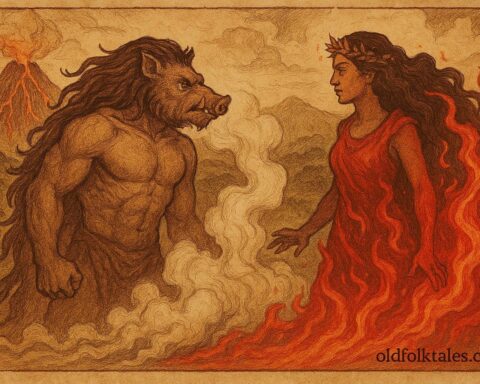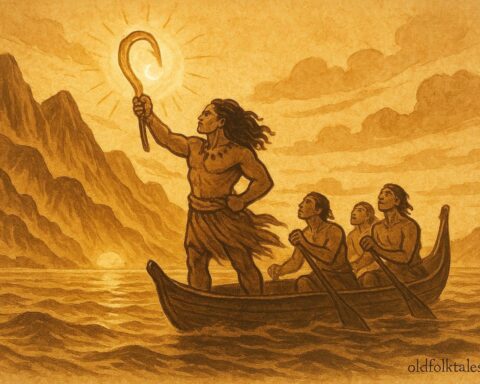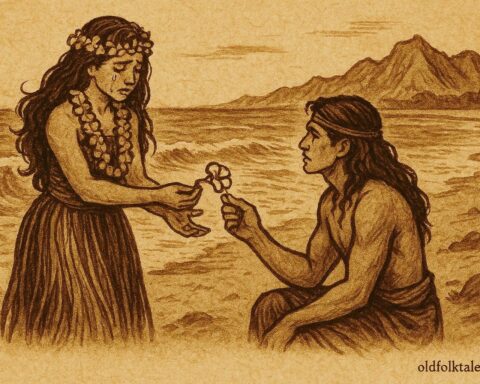In the time before the islands of Hawaii took their present form, the world was restless, and the earth’s breath burned beneath the ocean’s skin. From that molten fire came Pele, the goddess of volcanoes and the embodiment of creation through flame. Her spirit was fierce and radiant, her power vast as the sea she would one day challenge. This is the story of how Pele, guided by divine purpose and unyielding will, wandered across the Pacific to find her home in the heart of Kīlauea, the sacred mountain where fire and life are forever intertwined.
The Journey from Kahiki
Long ago, Pele lived in the faraway land of Kahiki, the ancestral homeland across the ocean. But even among the gods, her fiery spirit could not rest. Within her heart burned a hunger to find a place where her flames could live freely, where molten fire could rise from the earth without being quenched by the sea. Her restlessness became so great that it disturbed the peace of her family, for wherever she dwelled, the ground trembled and smoke rose from beneath her feet.
Sail through the legends of brave navigators, ocean spirits, and island gods
Her elder sister, Namakaokaha‘i, goddess of the sea, grew angry with her, for Pele’s fires threatened to consume the oceans themselves. Their conflict, the eternal struggle between fire and water, could not be contained. After a terrible quarrel, Pele fled Kahiki in a great canoe, sailing across the vast Pacific with her brothers and sisters. Among them were Kāmohoali‘i, the shark god who guided their voyage, and Kapo, the goddess of fertility and sorcery.
As the waves carried them across the endless blue, Pele’s spirit looked toward the horizon, searching for a land where her fire could take root. Her journey was both exile and destiny, a pilgrimage of creation that would shape the islands forever.
The First Fires
The canoe landed first at Kaua‘i. There, Pele tested the earth, driving her pāhoehoe fire deep into the ground. For a time, it glowed and smoked, and she thought she had found her home. But soon, Namakaokaha‘i felt the tremor of her sister’s fires. The sea goddess rose in fury, sending waves to crash against the island’s shores. She extinguished Pele’s flames and forced her to flee once more.
Undeterred, Pele and her divine company sailed southward to O‘ahu. Again, she dug her fire pits, one at Puowaina (Punchbowl Crater), another near Diamond Head. The land sizzled, the ground turned to glass, and smoke curled like the breath of a sleeping dragon. Yet again, Namakaokaha‘i’s waves found her, smothering the new-born fires.
Still, Pele would not yield. She traveled from island to island, to Moloka‘i, to Maui, and beyond, each time igniting the land with her sacred heat. Each time, her sister’s wrath drowned her efforts.
It was upon Maui that the sisters finally met in fierce battle. Namakaokaha‘i struck with storms and waves; Pele countered with thunder and molten rock. The earth shook, mountains cracked, and the sky turned red. At last, Namakaokaha‘i’s power overwhelmed Pele, and the goddess of fire fell, her body consumed in the flood of her sister’s rage.
But Pele’s spirit was not destroyed. From her fallen form, her divine essence descended deep into the earth. There, her eternal flame took root within the mountain of Kīlauea on the island of Hawai‘I, the youngest of the islands, and the most alive with fire.
Pele’s Eternal Home
From her sacred home within Kīlauea’s crater, Pele’s voice still speaks. The rumble of the earth is her chant; the glowing lava is her dance. Her spirit moves within the magma, shaping rivers of molten stone that cool into new land. Every eruption, every tremor, is not destruction alone, it is creation in motion.
To her people, Pele is both revered and feared. She is a goddess of life and death, of fury and beauty. Offerings of ‘ōhelo berries, ti leaves, and ‘awa are left at her altars to honor her power and to seek her protection. Travelers climbing the volcano still whisper prayers to her, for to disturb the land without reverence is to risk awakening her wrath.
Yet beneath her fiery nature lies a deeper truth, Pele’s journey is not merely a tale of destruction, but of transformation. She teaches that even the fiercest flame creates renewal; that every ending gives birth to new beginnings. The islands themselves, born of her fire, are living proof of her gift.
The Voice of Life Itself
When the lava meets the sea, it hisses and explodes, creating steam that rises into the sky. To the Hawaiians, that sound, the voice of the volcano, is sacred. It is the song of Pele, echoing across generations. It tells of the world’s constant rebirth, of the balance between power and peace, between the seen and the unseen.
Those who listen closely to the earth say they can still hear her, the whisper of magma beneath the surface, the heartbeat of fire beneath the soil. And they know: Pele lives not only in the volcanoes, but in every spark of creation, in every breath of change that shapes the world.
Discover the adventures of Māui, Pele, and Tangaloa in the timeless Polynesian oral tradition
Moral Lesson
The tale of Pele reminds us that creation often begins with destruction. Her fire, though fierce, brings forth life from the depths of the earth. In her journey, we learn that struggle and transformation are part of the same sacred rhythm, the balance that sustains the world. To honor Pele is to honor change itself.
Knowledge Check (Q&A)
1. Who is Pele in Hawaiian mythology?
Pele is the Hawaiian goddess of volcanoes, fire, and creation, revered as the divine force behind the islands’ formation.
2. What does Pele’s journey symbolize?
Her journey represents the power of transformation, creation through destruction and the eternal cycle of renewal in nature.
3. Why did Pele leave her homeland of Kahiki?
Pele left Kahiki after a conflict with her sister, Namakaokaha‘i, seeking a new home where her fires could live freely.
4. What lesson does Pele’s story teach?
The story teaches that destruction and creation are intertwined, even devastation can bring new life and purpose.
5. Where did Pele finally find her home?
Pele’s eternal home is in the volcano Kīlauea on the island of Hawai‘i, where her sacred fire still burns.
6. What does the “voice of the volcano” represent?
It symbolizes the living spirit of the earth, the balance of creation, destruction, and renewal guided by Pele’s divine will.
Source: Hawaiian Legends of Volcanoes: Pele and Her Kin by W. D. Westervelt (1916)
Cultural Origin: Hawaiian (Polynesian)












